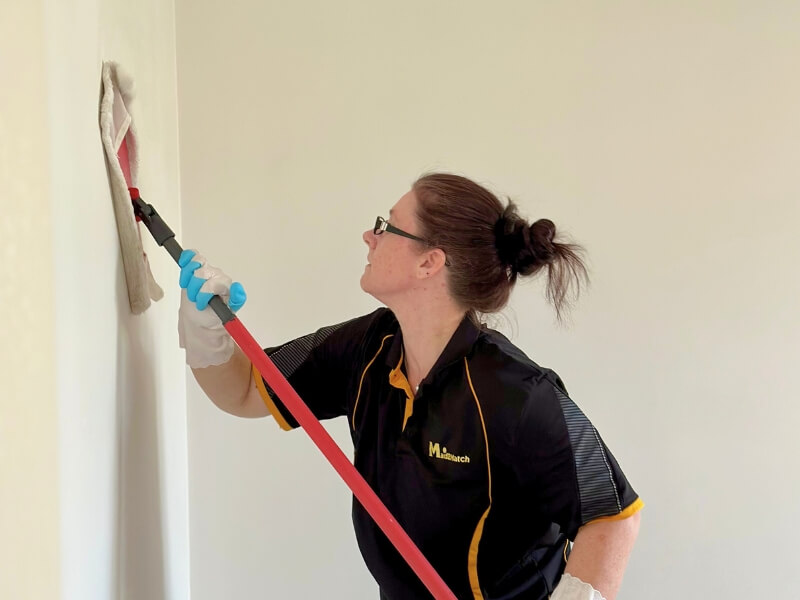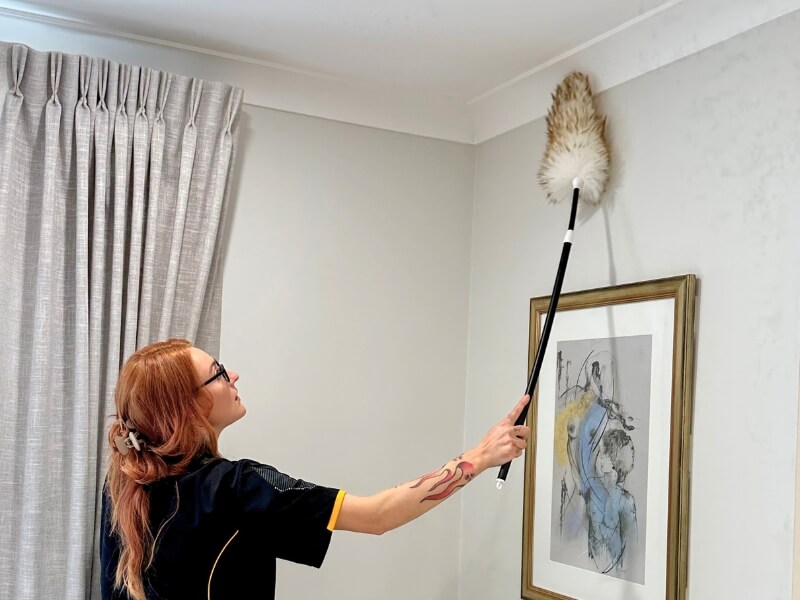Are you ready to give your kitchen walls a fresh new look? Before you grab that paintbrush, there’s one crucial step you can’t skip: cleaning your walls.
How to Clean Kitchen Walls for Painting. Dirt, grease, and grime build up over time and can stop paint from sticking properly. If you want your new paint to look smooth and last longer, you need to prepare your walls the right way. You’ll discover simple and effective ways to clean your kitchen walls, making sure your painting project turns out flawless every time.
Keep reading—you’ll be amazed at how easy it is to get your walls ready for a beautiful makeover.

Prepared clean kitchen wall ready for primer and paint
Gather Cleaning Supplies
Gathering the right cleaning supplies is the first crucial step before you start cleaning your kitchen walls for painting. Having everything on hand saves time and keeps the process smooth. It also ensures you clean thoroughly, so the paint adheres well and lasts longer.
Essential Cleaning Tools
Start with basic tools like a bucket, sponges, and scrub brushes. A microfiber cloth is perfect for wiping down walls without scratching the surface. You’ll also want a sturdy ladder or step stool to reach high spots safely.
Choosing The Right Cleaning Solutions
Not all cleaners work well on kitchen walls, especially if there’s grease or smoke buildup. A mix of warm water and mild dish soap often does the trick. For tougher stains, consider a vinegar and water solution or a commercial degreaser designed for kitchen use.
Protective Gear To Consider
Don’t forget gloves to protect your hands from harsh chemicals and hot water. If you’re using strong cleaners, goggles can shield your eyes from splashes. Wearing old clothes you don’t mind getting dirty can save your favorite outfit.
Extras That Make Cleaning Easier
- Magic erasers for scuff marks and stubborn spots
- Painter’s tape to mask off areas you don’t want wet
- Drop cloths to protect your floors from drips and spills
Have you ever started cleaning only to realize you’re missing a key item? Preparing your supplies ahead helps avoid that frustration.

Person rinsing and drying kitchen wall before painting
Remove Surface Dirt And Grease
Before painting your kitchen walls, removing surface dirt and grease is a must. These residues can prevent paint from sticking properly, causing uneven finishes or peeling later. Cleaning thoroughly sets a solid foundation for a smooth, long-lasting paint job.
Use Mild Detergent Solution
A simple mixture of warm water and mild detergent works wonders on everyday kitchen grime. Dip a soft sponge or cloth into the solution and gently scrub the walls in small sections.
Rinse the sponge frequently to avoid spreading dirt around. After scrubbing, wipe the walls with a clean damp cloth to remove any soap residue. Have you noticed how much easier painting goes when the surface feels completely clean?
Apply Degreaser For Tough Stains
Sometimes, regular detergent isn’t enough to tackle stubborn grease spots near the stove or backsplash. In these cases, a kitchen-safe degreaser is your best friend.
Spray the degreaser directly onto the greasy areas and let it sit for a few minutes to break down the oils. Then, scrub gently with a sponge or brush and wipe clean with a damp cloth. This extra step can save you from dealing with paint bubbles caused by hidden grease.
Wash Walls Thoroughly
Washing your kitchen walls thoroughly before painting is essential to achieve a smooth, long-lasting finish. Dirt, grease, and stains can prevent paint from adhering properly, leading to peeling or uneven color. Taking the time to clean your walls well will save you frustration and extra work later on.
Scrub With Soft Sponge Or Cloth
Use a soft sponge or cloth to scrub your walls gently. Avoid abrasive tools that can damage the surface and create rough patches. A mixture of warm water and mild dish soap works well to cut through grease and grime without harming the paint underneath.
Focus on areas around the stove and sink where buildup tends to be heavier. You’ll notice how much dirt hides in plain sight once you start scrubbing. Have you ever realized how much kitchen steam and cooking oils coat your walls over time?
Rinse With Clean Water
After scrubbing, rinse the walls with clean water to remove soap residue. Soap left on the wall can interfere with paint adhesion and cause problems down the line. Use a separate sponge or cloth soaked in water to wipe down the surfaces thoroughly.
Don’t rush this step. Take your time to ensure no soapy film remains. This final rinse will leave your walls ready to accept paint smoothly, making your effort truly worthwhile.
Treat Mold And Mildew Spots
Mold and mildew spots on kitchen walls not only ruin the look of your space but can also affect your health. Treating these spots effectively is crucial before you start painting. Ignoring them can cause the problem to resurface, ruining your fresh paint job and wasting your effort.
Apply Vinegar Or Bleach Solution
Both vinegar and bleach are powerful agents against mold and mildew. Vinegar is a natural choice and safe for most surfaces. Spray undiluted white vinegar directly on the spots and let it sit for about an hour. Then, scrub gently with a soft brush or cloth.
If the mold is stubborn, a bleach solution can work better. Mix one cup of bleach with one gallon of water. Apply this carefully with a sponge or spray bottle, avoiding excess drips. Always test a small area first to ensure the surface won’t discolor.
Remember, after applying either solution, wipe the area with a clean, damp cloth to remove residue. This step helps prevent damage and prepares your walls for priming and painting.
Ensure Proper Ventilation
Ventilation is key while treating mold and mildew. It helps the cleaning agents work effectively and keeps harmful fumes from building up. Open windows and doors or use fans to create airflow during and after the cleaning process.
Have you ever felt dizzy or nauseous after using strong cleaners in a closed room? That’s your body warning you about poor air quality. Keeping the area well-ventilated not only protects your health but also speeds up drying time, which is essential before painting.
By treating mold and mildew properly and ensuring good ventilation, you set a solid foundation for a smooth, long-lasting paint finish. What’s your experience dealing with stubborn mold spots in the kitchen?
Repair Wall Imperfections
Repairing wall imperfections is essential before painting kitchen walls. Small cracks and holes can spoil the paint finish. Fixing these issues creates a smooth, clean surface. This step helps paint stick better and last longer. Proper repair improves the wall’s look and durability. Follow these tips to prepare your kitchen walls perfectly for painting.
Fill Cracks And Holes
Start by cleaning the cracks and holes with a brush. Remove any loose debris or dust for better adhesion. Use a high-quality wall filler or spackle to fill the gaps. Apply the filler with a putty knife, pressing it firmly into the cracks. Smooth the surface by spreading the filler evenly. Let it dry completely, following the product instructions. For deep holes, apply filler in layers, allowing each to dry before adding more.
Sand Smooth Surfaces
After the filler dries, sand the repaired areas gently. Use fine-grit sandpaper to avoid damaging the wall. Sand until the surface feels smooth and level with the rest of the wall. Wipe the dust off with a damp cloth or sponge. This step ensures a flawless finish and better paint adhesion. Smooth surfaces prevent paint from chipping and peeling over time.
Final Wall Preparation
Before you pick up that paintbrush, your kitchen walls need one last round of attention. Final wall preparation ensures your paint sticks well and looks smooth. Skipping this step can lead to peeling or uneven color, turning your hard work into a frustration.
Remove Dust And Debris
Dust and tiny particles can ruin a fresh paint job. Use a microfiber cloth or a vacuum with a brush attachment to sweep the walls gently. Don’t rush this; even a small amount of dust can cause paint to bubble or flake later.
If you notice stubborn spots or cobwebs, a damp sponge works wonders. Just make sure the wall dries completely before moving on. Have you checked every corner and edge? Missing a spot could mean touch-ups later.
Mask Areas Not To Be Painted
Protecting your cabinets, countertops, and appliances saves you from tedious cleanup. Use painter’s tape along edges where walls meet other surfaces. Press the tape down firmly to prevent paint from seeping under.
Cover larger areas with plastic sheets or old newspapers. This simple step keeps your kitchen tidy and your focus on the walls. What’s more frustrating than painting a wall only to discover paint splatters on your favorite backsplash?

Degreasing kitchen wall surface for paint prep
Frequently Asked Questions
How Do I Prepare Kitchen Walls For Painting?
Start by removing grease, dirt, and stains with warm soapy water. Rinse with clean water and let dry. Fill holes or cracks with spackle, then sand smooth before painting.
What Cleaning Solution Works Best For Kitchen Walls?
A mixture of warm water and mild dish soap works well. For tough grease, add a small amount of vinegar or baking soda. Avoid harsh chemicals that can damage paint or drywall.
Should I Remove Old Paint Before Repainting Kitchen Walls?
Not always necessary if the old paint is intact. Clean the surface thoroughly and sand lightly for better paint adhesion. Remove peeling or flaking paint before repainting.
How Long Should Kitchen Walls Dry Before Painting?
Allow walls to dry completely, usually 1 to 2 hours. Ensure no moisture remains to avoid paint adhesion problems or bubbling after painting.
Conclusion
Cleaning kitchen walls before painting is crucial for a smooth finish. Dirt and grease can ruin fresh paint. Use mild soap and water. Scrub gently but thoroughly. Rinse and dry completely. Ensure no residue remains. This simple process prepares your walls.
It makes painting easier. Your kitchen will look fresh and clean. Enjoy a beautiful, renewed space. A little effort goes a long way. Happy painting!

